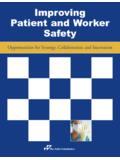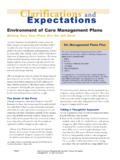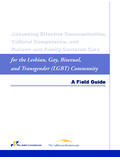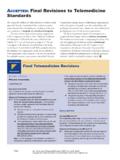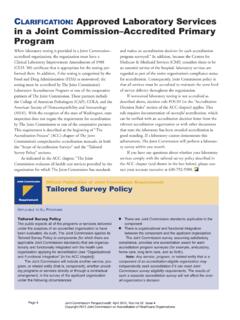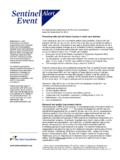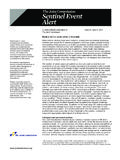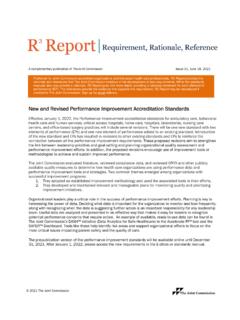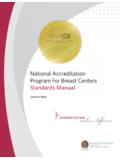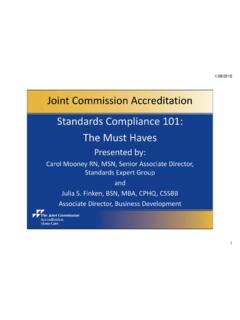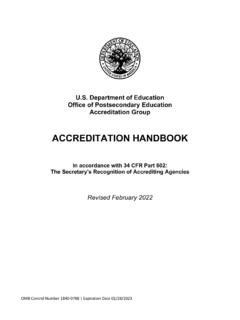Transcription of Behavioral Health Care Standards Sampler - Joint Commission
1 Behavioral Health care Standards Sampler Behavioral Health care Standards Sampler Introduction The Comprehensive accreditation Manual for Behavioral Health care (CAMBHC) contains the set of Standards that have been designed to evaluate a variety of Behavioral Health care settings including mental Health services, addiction treatment, and services for children, youth and families. This includes programs, settings and services such as outpatient or residential services, intensive outpatient/partial hospitalization programs, group homes, family preservation/wraparound programs, wilderness/outdoor programs, therapeutic schools, and foster care . To help familiarize you with the accreditation requirements while you are in the early stages of exploring accreditation , The Joint Commission has prepared this Standards Sampler , which contains a few select requirements from our accreditation chapters to illustrate the types of areas that accreditation addresses.
2 About Standards Applicability The Joint Commission surveys many types of organizations under the Behavioral Health care Standards . Accredited providers may serve individuals throughout their life span, or specialize in age and disability groups. Organizations may also operate in a variety of settings. The population served, the programs and services offered, and the setting in which the organization operates will factor into determining the applicable Standards for each organization. Not all of the requirements in this Sampler may apply to your unique organization. To identify those requirements applicable to your organization, check the Standards Applicability Process chapter in the Comprehensive accreditation Manual for Behavioral Health care (CAMBHC) or create your organization s unique profile of programs and services in our on-line Standards manual, the E-dition.
3 Structure of the accreditation Requirements The Standard itself is a statement that defines high level performance expectations, structures and processes which must be in place for an organization to provide safe, high-quality care , treatment or services. An organization is scored as either compliant or not compliant with a standard. accreditation decisions are based on simple counts of the Standards scored not compliant. The Rationale is a statement that provides background, justification, or additional information about a standard. A standard s rationale is not scored. Not every standard has a written rationale. Elements of performance (EPs) are specific performance expectations or structures or processes that must be in place.
4 Every standard has at least one EP. An EP compliance score determines a provider s overall compliance with a standard. i 1 Contents care , Treatment, and Services (CTS)..2 Environment of care (EC)..4 Emergency Management (EM)..5 Human Resources Management (HRM).. 6 Infection Prevention and Control (IC)..7 Information Management (IM)..8 Leadership (LD)..9 Life Safety (LS)..10 Medication Management (MM)..11 Performance Improvement (PI)..12 Record of care , Treatment, and Services (RC)..13 Rights and Responsibilities of the Individual (RI)..14 accreditation Participation Requirements (APR)..15 Behavioral Health Home Obtaining the accreditation Resources for 2 care , Treatment, and Services (CTS) The care , Treatment, and Services (CTS) chapter reflects the flow of care , treatment, and services as they are provided in Behavioral Health care organizations.
5 care , treatment, and services are provided through the successful coordination and completion of a series of core processes that include the following: Entry to care , treatment, or services Screening and assessment Planning of care , treatment, or services Delivery of care , treatment, or services Special Behavioral procedures Continuity of care , treatment, or servicesThese core processes also address the following activities: Providing care , treatment, and services based on principles of recovery and resilience. Providing individuals with access to the appropriate programs and services with appropriate staff. Providing care , treatment, and services based on an individualized plan.
6 Teaching individuals served what they need to know about their care , treatment, and services. Coordinating care , treatment, and services, if needed, when the individual is referred, transferred, : CTS : The organization has a screening procedure for the early detection of risk of imminent harm to self or others. CTS : For organizations providing residential care : The organization screens all individuals served to determine the individual s need for a medical history and physical examination. (This standard does not apply to organizations that provide physical examinations to all individuals served as a matter of policy or to comply with law and regulation.) CTS : A complete and accurate assessment drives the identification and delivery of the care , treatment, and services needed by the individual served.
7 : The organization identifies individuals served who may have experienced trauma, abuse, neglect, or exploitation. CTS : For organizations providing care , treatment, or services to individuals with addictions: The assessment includes the individual s history of addictive behaviors. CTS : For Foster care : The organization screens and assesses each individual to determine needed services and placement, including: a physical status screening a developmental status screening an educational status screening an emotional status screening a Behavioral status screening a social status screening a legal status screening a spiritual status screening a cultural and linguistic status screening3 care , Treatment and Services, Cont d CTS : For foster and/or respite care : The organization assesses each prospective foster parent or respite caregiver to determine whether he or she is eligible to be a foster parent or respite caregiver.
8 CTS : The organization has a plan for care , treatment, and services that reflects the assessed needs, strengths, preferences, and goals of the individual served. EP 3: The objectives of the plan for care , treatment, or services meet the following criteria: They include steps to achieve the goal(s) They are sufficiently specific to assess the progress of the individual served They are expressed in terms that provide indices of progressCTS : The plan for care , treatment, or services addresses the family s involvement. CTS : For organizations providing care , treatment, or services to children or youth: The plan for care , treatment, or services reflects needed educational services for every child or youth whose care , treatment, or services cause a significant absence from school.
9 CTS : For organizations that conduct outdoor/wilderness experiences: The organization safely conducts outdoor/wilderness experiences. (Note: This standard refers to an activity conducted for therapeutic reasons in remote areas away from the organization s premises [for example, a wilderness experience]. It does not refer to daily activities that may be conducted outside, such as going to community parks.) EP 1: For organizations that conduct outdoor/wilderness experiences: Prior to the individual served engaging in an outdoor/wilderness experience, the organization communicates to its staff any special precautions related to the individual of which staff should be aware.
10 EP 2: For organizations that conduct outdoor/wilderness experiences: The organization has a written plan to manage emergency situations that could occur during an outdoor/wilderness experience that includes the following: - How the organization will contact staff during the experience- How staff will contact the organization during the experience- How to handle a natural emergency (for example, weather, fire, landslide)- How to conduct an evacuation- How to remove an individual served from the experienceCTS : For organizations that provide care , treatment, or services to young adults with life transition needs: The organization assists young adults with their life transitions in accordance with their needs.

